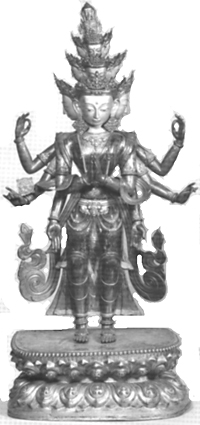The most famous cultivation technique in the Shurangama Sutra is the method reported by the Bodhisattva Kuan-Yin, who used hearing to realize the self-nature. Using hearing, she was able to enter samadhi and ultimately attain complete enlightenment. Manjushri, who is the Buddha of Wisdom and teacher of the other Buddhas, said that this technique surpassed all the other dharma doors in existence.

A cultivation saying runs, “Whoever hears the sound of water without using the sixth consciousness for thirty years will achieve Kuan-Yin’s all-pervading wisdom.” So in this practice, you let sounds come to your ears without trying to distinguish them. Remaining natural, relaxed, and detached, you spontaneously know what the sounds are without trying to recognize them or deliberate their meaning. Eventually you will find you can hear quiet as well as sounds, and will discover that they are both the same thing—sounds and silence are both objects of hearing, they’re both phenomena. Sounds, and the state where they’re absent, will still exist but will start to seem more and more separate from yourself. Since now they have less to do with you, they won’t bother you so much anymore and you can detach from them both to enter into samadhi.
A famous individual who used this technique was the Chinese Zen monk Han-shan, who practiced Kuan-Yin’s method of hearing on a bridge next to a noisy torrent of water. Han-shan reported that at first the noise of the water was quite audible, but in time it could only be heard when his thoughts arose, and not when they ceased. Then one day, his practice improved such that he did not hear the sound of the water any longer: sounds and noises vanished completely.
When describing this method in the Shurangama Sutra, Kuan-Yin said:
I entered into the stream of the self-nature of the sense of hearing, thereby eliminating the sound of what was heard. Now procceding from this stilllness, both sound and silence ceased to arise. Advancing in this way, both hearing and what was heard melted away and vanished. When hearing and what is heard are both forgotten, then the sense of hearing leaves no impression in the mind. When sense and the objects of sense both become empty, then emptiness and sense merge and reach a state of absolute perfection. When emptiness and what is being emptied are both extinguished, then arising and extinction are nuturally extinguished. At this point the absolute emptiness of nirvana became manifest, and suddenly I transcended the mundand and supra-mundane worlds.
In this method, you listen to and gradually detach from both sound and silence. When there’s no sound, we call this silence, and we conventionally say there is no hearing. But that doesn’t mean that the nature of hearing has ceased. It’s simply that the function of hearing now recognizes a state of no sound, or silence. Since the nature of hearing can ascertain the state of sound and no sound, it’s easy to use this method to realize the nature of duality and then to detach from both existence and non-existence. That’s the method of practice.
Both quiet (stillness or silence) and un-quiet (sound or disturbance) are phenomena, so tying oneself to either extreme is wrong. That’s why the state of samadhi (mental quiet) isn’t Tao either, even though you need to practice samadhi in order to awaken self· realization. for instance, if you don’t detach from the phenomenon of silence, you’ll never find out what’s hearing silence. Thus the quiet one recognizes in samadhi is not Tao, and the task you must perform is to return the hearing to hear the self-nature.
To progress past the quiet calm of samadhi through continued cultivation efforts, you must also practice prajna-wisdom. All the various methods of cultivation first get you to the point where the mind is calmed and still, but this doesn’t qualify as perfect penetration to the vast source of the mind. It’s just a phenomenal realm of quiet, another false creation of the mind. To attain Tao you must shine awareness on this state, without engaging in some form of mentation, so as to go further and achieve some genuine realization. That’s the practice of prajna-wisdom.
As Kuan-Yin said, you must cultivate to the extent that your awareness of samadhi and the state of samadhi both become extinct. Then it is real samadhi. Proceeding in this manner, you will eventually reach enlightenment. What is Kuan-Yin’s method? It’s withdrawing your energy from a focus on the outside, turning the function of hearing around to return it to its source. Hearing returns to listen to its self-nature, and through this method you can penetrate through all the various obstructions to achieve ultimate enlightenment.
♦
Excerpted from Twenty-Five Doors to Meditation: A Handbook for Entering Samadhi by Lee Shu Mei and William Bodri.